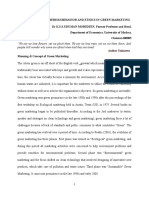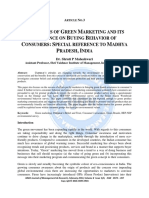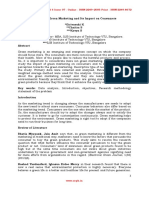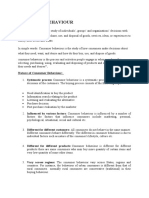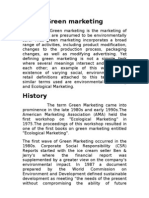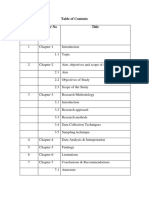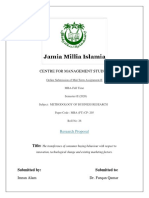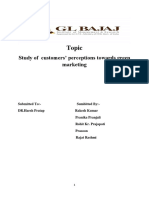Green Consumption...
Green Consumption...
Uploaded by
cpmrCopyright:
Available Formats
Green Consumption...
Green Consumption...
Uploaded by
cpmrCopyright
Available Formats
Share this document
Did you find this document useful?
Is this content inappropriate?
Copyright:
Available Formats
Green Consumption...
Green Consumption...
Uploaded by
cpmrCopyright:
Available Formats
64
Opinion-Volume 1, No. 1, December 2011
Green Consumption
An Empirical Study of Consumers Attitudes and Perception regarding Eco-Friendly FMCG Products, with special reference to Delhi and NCR Region
Dr. Sachin S. Vernekar* Preeti Wadhwa**
Abstract
The growing social and regulatory concerns for the environment lead an increasing number of companies to consider green issues as a major source of strategic change. In particular, this trend has major and complex implications on the technological strategy of a company and on its product innovations. Even though it is increased eco-awareness of Indian customers during the past few decades, there are some barriers to the diffusions of more ecologically oriented consumption and production styles. Therefore, companies are increasingly recognizing the importance of green marketing concepts. This exploratory study examined differences among ecologically-concerned and non-ecologically-concerned consumers with respect to their personal and social characteristics, and their perceptions of the marketing of green products. Significant differences were found in terms of attitudes and personality traits among green and non-green consumers. The purpose of study was to investigate the consumer attitudes and perceptions towards eco- friendly products in FMCG sector and their willingness to pay on green products. This study was based on both primary and secondary data. The primary data were collected from the sample survey that was conducted in the Delhi and NCR. 160 respondents were selected for the survey and respondents were asked to answer the prepared questionnaire. The questionnaire was designed to obtain the consumers attitudes and perception regarding eco-friendly FMCG products under four value added areas such as product designing, packaging, place and promotion that lead towards the motivation of consumption. The secondary data were collected from relevant journals, books and other published data. The study revealed that the green products have substantial awareness among Urban Indian customers and they are willing to pay something more on green products. The majority of customers considered that package is most important element of such products. We have recommended some marketing strategies to meet changing mind set of customers towards the green products. Keywords: Eco-awareness, Green, Green Marketing, Consumer attitude, Marketing strategies
*Director, Bharati Vidyapeeth University, Institute of Management & Research, New Delhi, India **Assistant Professor, Bharati Vidyapeeth , University, Institute of Management & Research, New Delhi, India
Green Consumption An Empirical Study of Consumers Attitudes and Perception regarding ......
65
Introduction
Whole World is identifying the need of the Green Marketing, Environmental Marketing and Ecological marketing which gives the same meaning to the research area. Although environmental issues influence on all most all activities in our day today lives, there were only few academic disciplines have discussed green issues in Indian market context. Especially from Indian business discipline, FMCG sector is a considerably large sector in the economy which has to open their eyes on eco friendliness. As society becomes more complex with the environmental pollution and unethical business practices, now both consumers and business organizations are concerned with the natural environment. So businesses have begun to modify their behavior in an attempt to address this societys new concerns .The FMCG sector is one of growing industry that concern about the green marketing issues. Most of marketing practitioners are using green elements as powerful marketing tools. In this context, this study focus on examine the consumer attractiveness towards green products of FMCG Sector. This paper seeks to answer basic questions about Indian consumers personal and social characteristics that influence environmentally-friendly consumption decisions and the role of external agents, such as government agencies and private firms, in facilitating the adoption of green products and services. Since the green movement in India is still in its infancy stage, this is one of the initial research attempts to provide a descriptive profile of the environmentally-concerned consumer and assess the relative influence of the fledgling green marketing movement in encouraging environmentallyfriendly consumption behavior among Indian consumers. The green consumer is generally defined as one who adopts environmentally-friendly behaviors and/or who purchases green products over the standard alternatives. In this study, the terms green, environmentally-friendly and ecologically-conscious are used interchangeably. Green or environmentally-friendly products are broadly defined as products that will not pollute the earth or deplete natural resources, and can be recycled or conserved. The green products of interest in this study are FMCG products since they are most affected by environmental concerns and are sold in retail outlets in
India. The basic objective of this paper is therefore to explore differences between green and non-green Indian consumers on personal, social and marketing mix dimensions. Evolution: The global changes in the environment are becoming critical not only for the consumers but also for the managements across the globe. Despite the fact that loads of environment protecting rules and regulations have been put into practice, there is a general belief that these laws lack competitiveness. The green evolution has evolved steadily over the period of time. There were initially three long phases in the evolution of the much hyped green marketing. The first phase was known as the ecological phase. In this phase, all the marketing activities were carried out in order to assist the ever increasing environmental problems and offer solutions for these problems. The second phase was called the environmental phase as after the environmental problems, the entire focus was shifted on the implementation of cleaner technologies. This phase also led to the discovery or the invention of products that would better the environment or at least not increase the already existing problems. The last phase is termed as the sustainable phase of green marketing which is still prevalent. This phase came into existence by the late nineties and early millennium. With the human wants escalating heavily, the resources are decreasing. Hence it has become mandatory for the marketers across the globe to use the resources efficiently and not waste them under any circumstances. World wide surveys indicate that consumers globally are changing their behaviour towards products and services. Green marketing is almost inevitable as the market for socially responsible products is increasing greatly. Over the relatively short history of green marketing, a movement that began as a way to incentivize the production of environmentally friendly products has degenerated into a mishmash of ideas, ethics, and confusion about what green products really are. Take one product, attempt to make it environmentally friendly, and then tell everybody about it. That is current green marketing in a nutshell. With few standards, and very little labeling of any significance, the right to call a product environmentally friendly is
66
Opinion-Volume 1, No. 1, December 2011
practically limitless. Authenticity of labeling has further lost creditability as the pseudo-accepted authority, EnergyStar, has recently undergone an embarrassment in which some of the more egregious products deemed efficient were exposed for example, the approval of a gas-powered alarm clock. Corporations are stepping up to become socially accountable. Companies have more than one reason to produce environmentally friendly products. Sustainability usually encourages efficiency. Creating a sustainable process for manufacture and distribution often results in lower overall costs in the long run. Once companies get over the sticker shock of the capital investments required to renovate and reduce environmental damage, they often realize that net revenues will increase. Although consumers often believe the claims companies make about products being environmentally friendly, the true test is the amount of carbon each product creates. Surveys indicate that 78% of consumers consciously attempt to buy products that are environmentally friendly, but the problem remains pinpointing how to utilize a sustainable preference. Further confusing the issue are the varying degrees of consumer interest in green products. According to Mintel, currently 12% of consumers are classified as those that attempt to buy a green product every time they make a purchase, while 68% of consumers will only occasionally pursue a green option. Marketers must include this discrepancy along with a consumers preference for price, quality, and luxury. Many marketers take advantage of this confusion to exaggerate their claims or make their products appear to possess attributes that have no relevance on the determination of sustainability. There is a market for green products, a market that will yield considerable profit, but the crux of green marketing is understanding how to exploit demand in the green market. Some companies have been able to create products with an emphasis on green initiatives that appeal to consumers. Perhaps one of the best examples is the compact fluorescent light bulb (CFL).
Literature Review
The trend is that consumers are moving to greener products. The Mintel organization reported results from
a study which indicated that the number of consumers who do buy green, has tripled in recent years. (Makower 2007) Further, it found that the numbers of customers, who never buy green products, has decreased by half. Consumers appear most willing to buy green household products but tend not to buy environmentally friendly clothes, personal care or toys. Mintels studies identified the green consumer by demographic characteristics. Green consumers are sometimes thought to be younger, better educated and more upscale than their non green counterparts. 1 8-24 year olds, who constitute the youngest age group studied, are the greenest consumers by far. (Makower 2007) Yet other research has found no significant age difference impacting the consumption of green products. (Pickett-Baker and Ozaki 2008) Compounding this issue is the notion that this group of consumers is the least susceptible to traditional advertising messages and formats. (Shrum, McCarty and Lowrey 1995) The consumer products firm Seventh Generation, a pioneer in marketing green products, has experienced substantial growth in sales to over $100 million annually in part by the use of blogs and reaching out to college students in order to get them to demand that the universities use their environmentally friendly products. (Neff 2007) According to their studies, Hispanic and Asian populations are more likely to be green consumers than African Americans. Consumers with higher education levels are more inclined to buy green. (Mintel 2008) Consumers claim to care about the environment but seem to only make green purchasing decisions when there are immediate and tangible benefits other than being more environmentally friendly. Walmart the retailing mega giant has had considerable success with a green marketing campaign based towards a consumer euphemistically called The Walmart Mom (Brandweek 2009) These consumers are found to be very willing to go green. But the product must not compromise the lifestyle of her family. As long as the green product is of high quality and is reasonably priced this consumer is very reachable. Walmarts marketing campaign is therefore brand and benefit specific without focusing on the Walmart brand. The Boston Consulting Group (Manget 2009) reported that a consumer will not pay for a product based solely on its green attribute, that there must be some added value to the product such as
Green Consumption An Empirical Study of Consumers Attitudes and Perception regarding ......
67
better taste, better safety, or to help the customers save money (such as on a gas bill). It appears that brand reputation matters most to people when making a green purchasing decision. Only nine percent use green advertising as their main criteria. (Green Seal 2009) Research on consumers attitudes towards green goods has produced conflicting results in its analysis of whether or not consumers believe green products are of lower or higher quality. Green goods were originally stamped with a bad reputation for quality in the 1970s when natural green detergents were introduced at high prices, wouldnt clean well, and would clog up consumers washing machines.(Shoemaker 2005) Ottman (2002) states that 42% of people think that green products dont work as well as conventional ones. Will a consumer go green despite a drop in quality? And how can companies combat this misconception that their greener products dont perform as well as regular ones? Furthermore, grouping green products into one category is outdated because consumers attitudes toward green products vary between industries. (Manget 2009) BCGs study looked at ingestible products, products applied to the body, wearable products, plug in products and disposable products. Although results did vary between products almost half of the respondents in the countries surveyed indicated that green products offer comparable or superior quality over conventional alternatives. It has been observed that when consumers are forced to cut back on spending, green products are the first to go. (Ridgely 2008) The consumer seems to be in favor of green but whether or not the consumer is willing to pay for green remains unanswered. The effects of the weakening economy are taking their tolls on peoples budgets. This creates tension between the desire for high family value and supporting sustainable products. It forces people to choose between emotional desires and economic budget decisions. There are signs that consumer purchasing behavior changes as people adjust to fulfill their needs with less money. Some 65% of consumers feel that paying more for sustainable products is not an option. This suggests the need for brands to respond to growing consumer demands for value or from their green products.
Personal Characteristics
Consumer attitudes have been used in past studies to predict energy conservation, recycling and ecologicallyconscious purchase and use of products. Kassarjian (1971) studied consumers reaction toward a gasoline that reduced air pollution and found that there was a positive correlation between concern for air pollution and willingness to pay higher prices for it. Attitude toward air pollution (expressed by concern) was the most important variable in determining consumers behavior toward the product. Kinnear and Taylor (1973) investigated attitudinal and behavioral dimensions of ecological concern and found them to have marked effects on brand perceptions for laundry products. In a study conducted in West Germany, Balderjahn (1988) found that a positive attitude toward ecologicallyconscious living resulted in ecologically-responsible buying and using of products, including the use of automobiles. It also prompted consumers to publicly show environmental concern by signing ecologically relevant petitions and supporting or joing an antipollution organization. Past research has shown that socially- or ecologically- concerned consumers do possess certain personality traits that consumers low in social or ecological concern do not possess. Anderson and Cunningham (1972) found that social consciousness tended to vary inversely with dogmatism and conservatism. Personal competence (a feeling of mastery of ones personal life and environment) was slightly less effective as a discriminator, tending to vary inversely with social consciousness. Kinnear, Taylor and Ahmed (1974) explored the relationship between socioeconomic and personality characteristics of consumers and the amount of ecological concern. They found that the ecologically concerned consumer tended to perceive strongly that individuals could be effective in pollution abatement; was more open to or tolerant of new ideas; desired to understand the workings of things and scored moderately with respect to harm avoidance. Crosby, Gill and Taylor (1981) studied the concept of alienation as a personality variable to determine the ecological behavior of voting for the deposit law. Alienation, which was defined as powerlessness or meaninglessness and not isolation, was found to be very
68
Opinion-Volume 1, No. 1, December 2011
significant in predicting the behavior of voting for the deposit law. In other words, perceived consumer effectiveness and ecological behavior were strongly related. Balderjahn (1988) also studied the relationship between ecological concern and personalitiy variables: alienation, emotional expression and ideological control. The concept of ideology control was similar to the perceived consumer effectiveness dimension identified by Kinnear et al. 1974. He found that ideology control was more significant in predicting ecologicallyresponsible consumption patterns than alienation or emotional expressiveness. Consumers who were internally controlled saved more energy and displayed ecologically responsible buying and consumption patterns. Anderson and Cunningham (1972) discovered that cosmopolitanism was more effective than alienation in discriminating between high and low social consciousness, and that the socially-conscious consumer was more cosmopolitan and less alienated (that is, more socially involved or integrated). While demographics have been used by various researchers in determining ecologically conscious behavior, the results have not been consistent. Studies that have found significant relationships between ecological consciousness and demographics (e.g., Anderson and Cunningham 1972; Kinnear et al. 1974; Anderson, Henion and Cox 1975; Murphy 1978; Belch 1980; Van Liere and Dunlap 1980; Roper Organization 1990) generally suggest that environmentally-conscious consumers tend to be younger; are more highly educated; come from households with higher incomes; and have higher occupational status. Other researchers (e.g., Granzin and Olsen 1991; Crosby et al. 1981; Balderjahn 1988) found that demographics had little or no effect on environmental behavior. Although Websters (1975) socially concerned consumer was a nonconformist member of the upper middle class with a high family income, he concluded that demographics were not as good predictors as personality and attitude measures.
environmental behaviors and attitudes, the Roper Organization Inc. (1990) found some of the following marketing mix related reasons for not behaving in an environmentally-friendly manner: 1. The green alternatives were not functionally superior; 2. The green alternatives were too expensive; 3. The labels claiming that the product was environmentally-safe were not believable; and 4. The green alternatives were too difficult to find. The perceived relative advantage (e.g., quality and functional performance) of green products over standard alternatives is likely to influence their rate of adoption (Rogers 1983). The relative advantage of green alternatives would have to be weighed against their prices. The analysis of this cost-benefit relationship is complicated by the fact that prices of green products reflect other costs in addition to money costs. These include opportunity costs, energy costs and psychic costs. If the major benefits of green products, compared to the major costs are higher, then consumers will be motivated to purchase these products even if they are priced somewhat higher than non-green substitutes (Kotler and Zaltman 1971). The Roper Organizations (1990) survey found that consumers in general were not ready to bear the cost of improving the environment, in the form of higher prices for green products. Even the most environmentally committed group in the survey appeared to be highly price-sensitive, willing to pay only 7.4% more for green products and a fifth of them would pay nothing more. From focus group interviews of American consumers, Progressive Grocer (1990) reported that consumers were either not willing to pay more for green products or were willing to do so only if they liked the product or if the product was of comparable quality to the regular brand. In a study of Australian consumers, Suchard and Polonsky (1991) found that 61.5% of the respondents would pay more for environmentally safe products while 22.2% were unsure if they would pay more for green products. On the average, those respondents who indicated that they would pay more for green products were willing to pay between 15% and 20% more. The promotion and distribution of green products contribute to consumers awareness of the selection and
Marketing Mix Variables
Past research has largely focused on personal charateristics as correlates of ecological behavior. Very little has been done to examine the impact of green marketing efforts on the adoption of green products and services. In a study on the American consumers
Green Consumption An Empirical Study of Consumers Attitudes and Perception regarding ......
69
availability of green alternatives. This awareness, however, does not always lead to ecologically-friendly consumption decisions. A recent survey of Indian consumers by the Business India showed that almost all of the respondents interviewed indicated that they would like to know where to buy environmentally friendly products. But, they were not willing to pay a higher price for green products if they were priced higher than conventional products. In another instance, where green alternatives were known to be available in stores and sold side by side, standard brands outsold their green substitutes by as much as 30 to 1, even though the green substitutes were competitively priced.
Objectives: The Main objectives of the study are 1. To investigate the consumer attractiveness towards eco- friendly products in FMCG sector and their impact of purchasing decision. 2. To evaluate consumer attitudes and perception regarding eco-friendly FMCG products under four value-added areas such as product, package, place and promotion that lead towards the motivation of consumption.
Research methodology
Data Collection A detailed questionnaire was administrated. Meanwhile personal interviews and observations were also made. In order to ensure an acceptable number of responses, a convenience sample was used. Data were collected through the self administrated questionnaires by the researchers them selves and trained field assistants. The questionnaire comprised 24 questions including both close ended and open ended questions All close ended constructs used in this study were measured by various items on five-point Likert-type scales (1 ? completely disagree to 5 ? completely agree). It is widely believed that attitudes are best measured by way of multiple measures and the general trend in measuring environmental issues is via several items instead of single-item questions (Gill et al., 1986). The sample was drawn from Delhi, Gurgaon and Noida. Sample was selected using combination of convenience and simple random sampling method. As much as possible attempt was made to get the sample comparable basis for convenience of the analysis. Secondary data were collected by website published articles, newspapers, relevant journals etc. 40 size of sample was selected from University undergraduates who follow business management degrees, and the researches had a predetermined discussion with them before the product categories and brands were determined. Basically, they were asked to come up with the free ideas the products available in FMCG sector in India, with special attention paid on those of green marketing practices. Thereafter, researches determined the product categories such as food items, beauty soap and detergent respectively.
Conceptualization
In conceptualizing the study, we have attempted to build relationship between key variables of green marketing i.e., product, package, distribution and promotion (independent variables) and customer buying decision (dependent variable). Those relationships can be varied according to the demographic variables. Therefore demographic factors were considered as intervene variable of the conceptual framework. Figure 1 Conceptual Model
Consumer Demographic (Age, Gender, Education)
Elements of Green Marketing . Product . Package . Place and Distribution . Promotion
Purchase Decision
According to the literature and pilot study in Indian supermarkets, it was recognized that marketers can use different tools relating to independent variables in order to determine the effectiveness of green marketing practices. It is also necessary to examine the relationship between two key variables and other variables influenced on dependent variable This would help to interpret the findings in a more comprehensive manner.
70
Opinion-Volume 1, No. 1, December 2011
The sample comprised of 160 respondents from Delhi, Gurgaon and Noida. Respondent category comprised with university students, academic staffs, office workers, housewives, business people and managers of several companies those who have much exposure to the FMCG category and who represent the Indian customers. Table 1 Sample Profile
District Delhi Gurgaon Noida No. of respondents 62 52 46 160
Green marketing elements and Purchasing decisions Researchers observe the type of mean variances between each of the independent variables and the purchase decision of the consumers. Table 01 shows the correlation of each of the concepts, namely product, package, price, place and promotion and how each of those variables correlates to the purchase decision of FMCG products. Table2 Degree of relationship between testable variables Urban and Rural consumer
Variable - 1 Product Package Place & distribution Promotion Variable - 2 Purchase decision Purchase decision Purchase decision Purchase decision Pearsons Correlation Coefficient 0.612 0.51 0.212 0.428
Data Analysis Procedure
Descriptive statistical techniques were utilized to analyze the data with the help of SPSS package. The major statistical techniques, which were used in this study, are central tendency (Specially Mean), percentage analysis and the correlation analysis. Percentage and correlation values highlighted the salient features of the collected data, facilitated comparisons between variables and enabled the study relationships more readily. Percentage values were used to identify the contribution of various categories of each variable. The central tendency values used to identify the nature of attractiveness towards the each variable of eco friendliness. Answers for open ended questions had coded and categorized before analyzing
As per the study, in the above table variables classified independent variables into variable1 category and dependant variable purchase decision into variable2.The above analysis clearly shows that environment friendly products and packages make the significant impact of customer buying decisions. The marketing communication with the environment friendly product information will also significantly impact on the buying decisions.
Comparisons of Means of elements of green marketing against the demography
This study focused on the green marketing strategy and consumer buying decisions. The main objective of this study was to examine the influence emerged from green marketing strategy for consumers buying decisions of FMCG sector in India. The finding shows that influence emerged from green marketing strategies on consumers buying decisions is strong. The mean value of green marketing elements is 23.25. It is represented in strongly influenced score category (22-30). Mode and median values are 24.00 and 23.80 respectively However, green marketing elements consists of four variables such as product, package, place and
Findings and Discussions
Many firms and customers are beginning to realize that they are members of the wider community and therefore must behave in an environmentally responsible fashion. This translates into firms that believe they must achieve environmental objectives as well as profit related objectives. This results in environmental issues being integrated into the firms corporate culture. All most all in the sample generally want to do the right thing, so the challenge and opportunity for the green marketer is to make it easy for people to do so.
Green Consumption An Empirical Study of Consumers Attitudes and Perception regarding ......
71
promotion. Out of those variables, except eco friendly distribution and promotions as green products other variables strongly influence in selecting products of foods, beauty soap and detergents. The majority of respondents (57%) mentioned that promotions of green products strongly influence on their buying decisions. In the same time, 32% of respondents have indicated that promotions of green products strongly influence on their buying decisions. Moreover, the mean value of green promotion is 3.15. (See Annexure 01) It is more close to the lower level of strongly influenced score category (3.67 5.00). The findings show that 89% of respondents have indicated that eco-friendly packaging is strongly influenced on their buying behavior. The descriptive statistics relating to the green products mention that both mean and median belong to strongly influenced score category. However, the statistical distribution has multiple modes. Most of the customers mentioned that designing bio degradables packaging is one of the most important factors of product attractiveness. According to the findings, 62% of respondents and 36% of respondents have indicated bio- degradable packing will affect in a strong and moderate way respectively on their buying decisions. Even though distribution has not big involvement to the green marketing, 46% of consumers are willing to get the services from places and distribution channels which are not cause to environmental pollution.(eg. eco friendly hotels) and others go for any choice considering cost and convenience. And also, 62% of employees are willing to get the services from outlets which are not situated in the polluted environment. The mean value of green marketing outlets is 2.95. It is represented in moderately influenced score category (2.33 3.67). Therefore, the quantitative figures show that green marketing elements have significant impact on store choice decision in India. Customer attractiveness for green marketing elements Based on Demographic Variables. Another important finding was that all variables of green marketing elements are having more responses for the all age categories, gender, and education levels. That means except any demographic difference, customers are considering green marketing as the important factor in their store choice decisions. The findings show that both 18 30 and 31 -50-aged
customers highly consider eco-friendly packaging as the most important variable in their buying decisions of each product categories. However, 32 of 18 - 30 aged customers selected eco friendly package as the most important variable and 16 customers have selected green promotion as main variable. In addition, only 04 respondents have indicated that they consider distribution function as important variables for their decisions. The sample consists of 90 male customers and 70 female customers. A cross analysis was made in order to identify the relative importance of green marketing variables relating to the gender basis. Most of the male customers (37 respondents) consider eco friendly packaging as the most importance factor in selecting green products. However, most of female customers gave priority to green feature of in their selection. The both genders gave their next priority to promotion. This section focused on analyzing relative importance of green marketing variables under different education levels. The sample mainly consists of 62 graduates, 30 professionally qualified individuals and 44 customers who have completed secondary education (A/L passed). Generally, graduates, postgraduates and A/L passed customers have given first priority to green feature of products. In the same time, they have indicated eco friendly packaging is highly considered in selecting specific supermarket outlet. Most of the professionally qualified customers have selected eco friendly packaging as important variables in selecting the green products in the FMCG category.
Conclusion
Though consumers are willing to purchase green products, many business organizations still in behind the need of the eco friendly society. The authors suggest business organizations to follow strategies in order to get benefits from the environmentally friendly approach as green marketing offers business incentives and growth opportunities while it may involve start-up costs, it will save money in the long term. Therefore, in the product strategy, marketers can identify customers environmental needs and develop products to address this issue, produce more environmentally responsible packages. (Recycle, biodegradable, reuse), and ensure that products meet or exceed the quality expectations
72
Opinion-Volume 1, No. 1, December 2011
of customers. In addition to that marketer can charge high price with highlighting eco friendliness of the products. In the case of distribution, obtaining dealer support to green marketing practice is essential. And also, the location must differentiate from competitors and it can achieve by in-store promotions and displays by using recycled materials to emphasize the environmental and other benefits. Finally, organization can reinforce environmental credibility by using sustainable marketing and communications such as public relations and creative advertising associated with green issues in India. Green marketing should not neglect the economic aspect of marketing. Marketers need to understand the implications of green marketing. If we think customers are not concerned about environmental issues or will not pay a premium for products that are more ecoresponsible, think again. We must find an opportunity to enhance our products performance and strengthen your customers loyalty and command a higher price. Green marketing is still in its infancy and a lot of research is to be done on green marketing to fully explore its potential. Think of a refrigerator for example. While we may have had to be convinced in the 1950s to buy a refrigerator, we would have wanted the great white box to look cool in the 1970s, but in todays uncertain world, we might ask ourselves about the impact of the chlorofluorocarbons (CFCs) that our refrigerator is emitting and demand a more environmentally friendly refrigerator. So, if todays successful marketing is about appealing to personal values and delivering consumer empowerment, then surely the time is right to inject sustainable development into the marketing mix to help address some of the gritty issues currently facing our planet. Green marketing methods produce highly effective results. They apply all of the steps you need to cut costs, raise response rates and increase growth in the most important marketing metric we are all held accountable forthe bottom line.
green products desirable for consumers. Historically, green marketing has been a misunderstood concept. Business scholars have viewed it as a fringe topic, given that environmentalisms acceptance of limits and conservation does not mesh well with marketings traditional axioms of give customers what they want and sell as much as you can. In practice, green marketing myopia has led to ineffective products and consumer reluctance. Rising energy prices, growing pollution and resource consumption in Asia, and political pressures to address climate change are driving innovation toward healthier, more-efficient, high-performance products. In short, all marketing will incorporate elements of green marketing. As the authors of Natural Capitalism argue, a more sustainable business model requires product dematerialization that is, commerce will shift from the sale of goods to the sale of services (for example, providing illumination rather than selling light bulbs). To avoid green marketing myopia, the future success of product dematerialization and more sustainable services will depend on credibly communicating and delivering consumer-desired value in the marketplace. Only then will product dematerialization steer business onto a more sustainable path.
Recommendations
Practical implications A technique for understanding consumer willingness-to-pay (WTP) is provided and insights into differences are offered between products in terms of WTP for greener products. Practitioners can use this technique to determine the price range and indirectly the profitability of a version of their product based on recycled or reused content. Green marketing subsumes greening products as well as greening firms. Though normative concerns impact consumers and firms decision making, economic aspects of green marketing should not be neglected. Managers need to identify what ought to be greened: systems, processes or products? Consumer apathy to green products is due to many factors, including inadequate information about levels of greenness, lack of credibility of firms claims and the tendency to free ride. It also seems that green products that offer direct excludable benefits to consumers (such
The future of Green Marketing
Clearly, there are many lessons to be learned to avoid green marketing myopia. Effective green marketing requires applying good marketing principles to make
Green Consumption An Empirical Study of Consumers Attitudes and Perception regarding ......
73
as pharmaceuticals with minimum side effect and nutritious and natural foods) would have higher acceptability. Consumer apathy may also be attributed to the belief that individual actions alone cannot impact the macro picture, and collective endeavors are impeded by free riding.
Implications For Future Research
We have developed the following propositions as the next step for our research. P1: Green consumers will be driven by the personal or familial benefits of the product more so than the green benefits. P2A: Consumer segments who are strongly predisposed to buy green products distrust much of green advertising.
P2B: This is most prevalent for young consumers than their older counterparts. P3:Marketers should consider alternative methodologies in reaching those who are predisposed to buying green. P4: Consumers with neither strong positive nor strong negative attitudes towards green products are more likely to be persuaded by a non green benefits message than a green message. Future research should examine in greater depth the attitude-behavior inconsistencies arising from conflicts between internal (e.g., personal beliefs or lifestyle) and external (e.g., social conformity) pressures. Also, the effectiveness of various public and private environmental programs should be compared especially between those that involve moral suasion and financial incentives/disincentives.
References 1. Anderson, Thomas W. and William H. Cunningham (1972), The Socially Conscious Consumer, Journal of Marketing, 36 (July), 23-31. 2. Anderson, Thomas W., Karl E. Henion, and Eli P. Cox (1975), Socially vs Ecologically Responsible Consumers, in 1974 Combined Proceedings, ed. Ronald C. Curhan, Chicago: American Marketing Association, 304-311. 3. Balderjahn, Ingo (1988), Personality Variables and Environmental Attitudes as Predictors of Ecologically Responsible Consumption Patterns, Journal of Business Research, 17, 51-56. 4. Business Times (1992), Resolution on Environment and Development Adopted-Fifth Asean Meeting on the Environment, (February 19), Singapore. 5. Business Times (1991), The Changing Attitudes of Singaporeans to the Environment, (May 25), Singapore. 6. Crosby, Lawrence A., James D. Gill, and James R. Taylor (1981), Consumer/Voter Behavior In The Passage of The Michigan Container Law, Journal of Marketing, 45 (Spring), 19-31. 7. Granzin, Kent L. and Janeen E. Olsen (1991), An Investigation of the Characteristics of Participants in Conservation and Environmental Protection: An Emphasis on Helping Behavior, in 1991 AMA Educators Proceedings, eds. Mary G. Gilly et al., (Summer), Chicago: American Marketing Association, 177-186. 8. Kassarjian, Harold H. (1971), Incorporating Ecology Into Marketing Strategy: The Case of Air Pollution, Journal of Marketing, 35 (July), 61-65. 9. Kinnear, Thomas C. and James R. Taylor (1973), The Effect of Ecological Concern On Brand Perception, Journal of Marketing Research, 10 (May), 191-197..pa
74
Opinion-Volume 1, No. 1, December 2011
10. Kinnear, Thomas C., James C. Taylor, and Sahrudin A. Ahmed (1974), Ecologically Concerned Consumers: Who Are They? Journal of Marketing, 38 (April), 20-24. 11. D & B Reports (1990), The Selling of the Green, (September/October), 38 (5), 30-31/35. 12. Kotler, Philip and Gerald Zaltman (1971), Social Marketing: An Approach To Planned Social Change, Journal of Marketing, 25 (July), 3-12. 13. Murphy, Patrick E. (1978), Environmentally Concerned Consumers, in Proceedings of the 1978 Educators Conference, ed. Subash Jain, Chicago: American Marketing Association, 316-320. 14. Nunnally, Jum C. (1967), Psychometric Theory, New York: McGraw-Hill Book Company. 15. Progressive Grocer (1990), Consumers Speak Out on the Environment, (November), 16-22. 16. Rogers, Everett (1983), Diffusion of Innovation, New York: The Free Press. 17. The Roper Organization, Inc. (1990), The Environment: Public Attitudes and Individual Behavior, July. 18. Suchard, Hazel T. and Michael J. Polonsky (1991), A Theory of Environmental Buyer Behavior and Its Validity: The Environmental Action-Behavior Model, in 1991 AMA Educators Proceedings, eds. Mary C. Gilly et al., (Summer), Chicago: American Marketing Association, 187-201. 19. Van Liere, Kent D. and Riley E.Dunlap (1980), The Social Bases of Environmental Concern: A Review of Hypotheses, Explanations And Empirical Evidence, Public Opinion Quarterly, 44 (Summer), 181197. 20. Webster, Fredrick. E. (1985), Determining the Characteristics of the Socially Conscious Consumer, Journal of Consumer Research, 2 (December), 188-196. 21. http://storage.pardot.com/732/69771/Article_Green_Marketing_Edge.pdf
You might also like
- Verbal Classification Type1Document6 pagesVerbal Classification Type1mecitfuturedreamsNo ratings yet
- Opportunities For Green Marketing Young ConsumersDocument2 pagesOpportunities For Green Marketing Young ConsumersRíshãbh JåíñNo ratings yet
- Dissertation ProjectDocument73 pagesDissertation Projectmalti jNo ratings yet
- SYLLABUS Green MarketingDocument5 pagesSYLLABUS Green Marketingfra.1988No ratings yet
- ProjectDocument18 pagesProjectPrasad ArjunanNo ratings yet
- Green Marketing-Complete PaperDocument10 pagesGreen Marketing-Complete PaperTanya GrewalNo ratings yet
- Research On Green MarketingDocument19 pagesResearch On Green MarketingkhushboogeetaNo ratings yet
- Green Marketing in IndiaDocument11 pagesGreen Marketing in IndiaRavi GuptaNo ratings yet
- Green MarketingDocument5 pagesGreen MarketingPadmanabhan NsNo ratings yet
- Green Marketing ResearchDocument25 pagesGreen Marketing ResearchZeshan SipraNo ratings yet
- Green Buying Behavior in Indian Consumers StudyDocument16 pagesGreen Buying Behavior in Indian Consumers Studysalil2509100% (1)
- Green MarketingDocument13 pagesGreen MarketingKuthubudeen T MNo ratings yet
- 3 DR Shruti P MaheshwariDocument14 pages3 DR Shruti P MaheshwariklklklNo ratings yet
- Awareness of Green MarketingDocument44 pagesAwareness of Green MarketingSonali Zende100% (1)
- Research Paper On Consumer Behaviour Towards Eco-Friendly ProductsDocument12 pagesResearch Paper On Consumer Behaviour Towards Eco-Friendly ProductsJagritiChhabra100% (1)
- Research Paper On Green MarketingDocument8 pagesResearch Paper On Green Marketingsonia100% (1)
- 10 Green Marketing TrendsDocument4 pages10 Green Marketing TrendsYash GuptaNo ratings yet
- Green MarketingDocument56 pagesGreen MarketingShubhamBhatnagarNo ratings yet
- Project of BR (ORGANIC PRODUCT)Document35 pagesProject of BR (ORGANIC PRODUCT)Amit Solanki100% (1)
- Consumer Behaviour ReportDocument21 pagesConsumer Behaviour ReportSidharth ChoudharyNo ratings yet
- Green MarketingDocument36 pagesGreen MarketingBikramjeet MaanNo ratings yet
- Factors Affecting Green Marketing in India A Study of Metro Consumers Artee AgarwalDocument180 pagesFactors Affecting Green Marketing in India A Study of Metro Consumers Artee AgarwalSusovan BhowmickNo ratings yet
- A Study On Consumers Preference On Eco-Friendly Products in Coimbatore CityDocument6 pagesA Study On Consumers Preference On Eco-Friendly Products in Coimbatore CityIJAR JOURNALNo ratings yet
- A Study On Green Marketing and Its Impact On ConsumersDocument7 pagesA Study On Green Marketing and Its Impact On ConsumersarcherselevatorsNo ratings yet
- A Proposal of Project Report On "Impact On Green Marketing On Consumer Buying Behaviour in Baroda "Document5 pagesA Proposal of Project Report On "Impact On Green Marketing On Consumer Buying Behaviour in Baroda "RahulNo ratings yet
- Effects of Brand Image On Consumer BuyinDocument53 pagesEffects of Brand Image On Consumer Buyinashish kothariNo ratings yet
- Green Marketing in India Challenges andDocument13 pagesGreen Marketing in India Challenges andAmirul FathiNo ratings yet
- Green ConsumerismDocument19 pagesGreen ConsumerismKrutika GoyalNo ratings yet
- Green Marketing in Indian PerspectiveDocument62 pagesGreen Marketing in Indian Perspectivejeetbalraj_243486915No ratings yet
- Green MarketingDocument8 pagesGreen MarketingDrRam Singh KambojNo ratings yet
- Consumers Purchase Behavior Towards Green Products 1Document15 pagesConsumers Purchase Behavior Towards Green Products 1Anonymous t3GpQRwOHNo ratings yet
- A Study On Buying Behavior of Filipino Teens Related To Facial Care ProductsDocument10 pagesA Study On Buying Behavior of Filipino Teens Related To Facial Care ProductsRomeo ChuaNo ratings yet
- The Effects of Green Marketing Mix On Consumer Behavior in Danang CityDocument6 pagesThe Effects of Green Marketing Mix On Consumer Behavior in Danang CityInternational Journal of Innovative Science and Research TechnologyNo ratings yet
- Consumer BehaviourDocument17 pagesConsumer BehaviourMridul royNo ratings yet
- Green MarketingDocument37 pagesGreen Marketingronak_gopuuNo ratings yet
- Assignment Repositioning DaburDocument4 pagesAssignment Repositioning DaburRupesh Shah100% (1)
- Executive Summary SapnaDocument53 pagesExecutive Summary SapnaSapna Somani100% (1)
- Green Marketing Questionnaire PDFDocument17 pagesGreen Marketing Questionnaire PDFSekar MuruganNo ratings yet
- Green Marketing - NotesDocument4 pagesGreen Marketing - NotesAyush Mittal100% (1)
- Green MarketingDocument36 pagesGreen MarketingBikramjeet MaanNo ratings yet
- MBA 2nd-Research-Paper-on-Marketing-EthicsDocument15 pagesMBA 2nd-Research-Paper-on-Marketing-EthicsYadav Manish KumarNo ratings yet
- Packaging FGFDocument34 pagesPackaging FGFAditi Chakraborty0% (1)
- Research Paper On Consumer Behaviour Towards Eco Friendly ProductsDocument12 pagesResearch Paper On Consumer Behaviour Towards Eco Friendly ProductsManish here100% (1)
- Synopsis Green MarketingDocument8 pagesSynopsis Green MarketingItisha GuptaNo ratings yet
- Green MarketingDocument15 pagesGreen MarketingJithin ShajiNo ratings yet
- Business Research MethodDocument21 pagesBusiness Research MethodHemal VyasNo ratings yet
- Green Marketing SurveyDocument116 pagesGreen Marketing SurveyGaganjot SinghNo ratings yet
- Serial No. Chapter No TitleDocument47 pagesSerial No. Chapter No TitleSwyam DuggalNo ratings yet
- Consumers Awareness Towards Green Marketing and Consumer Perception and Preferences in VaranasiDocument14 pagesConsumers Awareness Towards Green Marketing and Consumer Perception and Preferences in VaranasiInternational Journal of Innovative Science and Research TechnologyNo ratings yet
- Consumer Behavior Towards International BrandsDocument17 pagesConsumer Behavior Towards International BrandsAmna FarooquiNo ratings yet
- Introduction and Review of LiteratureDocument13 pagesIntroduction and Review of LiteraturePrasad Arjunan100% (1)
- Consumer Behaviour Unit I NotesDocument9 pagesConsumer Behaviour Unit I NotesMahesh BadalNo ratings yet
- Principles of PR Measurement 0 PDFDocument15 pagesPrinciples of PR Measurement 0 PDFVisai_kitasNo ratings yet
- The Role and Impact of The Packaging Effect On Consumer Buying BehaviourDocument9 pagesThe Role and Impact of The Packaging Effect On Consumer Buying BehaviourHafiz AdnanNo ratings yet
- A Study On Impact of Green Marketing Tools' On PDFDocument41 pagesA Study On Impact of Green Marketing Tools' On PDFSiva VidhyaNo ratings yet
- Centre For Management Studies: TitleDocument9 pagesCentre For Management Studies: TitleIMRAN ALAMNo ratings yet
- Green Products A Complete Guide - 2020 EditionFrom EverandGreen Products A Complete Guide - 2020 EditionRating: 5 out of 5 stars5/5 (1)
- Green Consumerism in IndiaDocument11 pagesGreen Consumerism in Indiasumitru100% (3)
- 20.vol - 01 - Issue - 05 Sudhir Sachdev Eco FriendlyDocument9 pages20.vol - 01 - Issue - 05 Sudhir Sachdev Eco FriendlynithyanandapatelNo ratings yet
- A Study of The Impact of Green Marketing Practices-309Document10 pagesA Study of The Impact of Green Marketing Practices-309Rahul100% (1)
- RMB ReportDocument10 pagesRMB ReportMack RaoNo ratings yet
- Issues in Neuro - Management Decision MakingDocument14 pagesIssues in Neuro - Management Decision MakingcpmrNo ratings yet
- Vision Based Real Time Finger Counter For Hand Gesture RecognitionDocument5 pagesVision Based Real Time Finger Counter For Hand Gesture RecognitioncpmrNo ratings yet
- Modeling An Oil Drilling Rig Total Productive ...Document10 pagesModeling An Oil Drilling Rig Total Productive ...cpmrNo ratings yet
- Danger of Burning OutDocument6 pagesDanger of Burning OutcpmrNo ratings yet
- Distance Education in India: Problems or Barriers To LearningDocument9 pagesDistance Education in India: Problems or Barriers To LearningcpmrNo ratings yet
- Teaching With Emotional Intelligence in Higher EducationDocument6 pagesTeaching With Emotional Intelligence in Higher Educationcpmr100% (1)
- Consumer's Environmental Concern...Document8 pagesConsumer's Environmental Concern...cpmrNo ratings yet
- A Comparative Study On Investment Pattern...Document9 pagesA Comparative Study On Investment Pattern...cpmrNo ratings yet
- Exploring Unique Corporate Leadership Styles in IndiaDocument13 pagesExploring Unique Corporate Leadership Styles in IndiacpmrNo ratings yet
- Problems and Challenges Faced by Women Entrepreneur in IndiaDocument8 pagesProblems and Challenges Faced by Women Entrepreneur in IndiacpmrNo ratings yet
- A Study On Indian Consumers' Attitude Towards SMS ...Document6 pagesA Study On Indian Consumers' Attitude Towards SMS ...cpmrNo ratings yet
- Book Franciacorta enDocument54 pagesBook Franciacorta enRodrigo Valadez AguileraNo ratings yet
- PavarotiDocument2 pagesPavarotiAna PetrovicNo ratings yet
- Oba 4 BKSDocument6 pagesOba 4 BKSNAMRTHA RATHNAKUMARNo ratings yet
- Vivaldi: Laudate Pueri Dominum, RV 600Document13 pagesVivaldi: Laudate Pueri Dominum, RV 600botmy banmeNo ratings yet
- Unit PlanDocument7 pagesUnit Plan885896No ratings yet
- Financial Performance Analysis of Nestle India LTD: Amal BijuDocument87 pagesFinancial Performance Analysis of Nestle India LTD: Amal BijuVranda AroraNo ratings yet
- SI Project Implementation PlanDocument5 pagesSI Project Implementation PlanRonald CortezanoNo ratings yet
- Geospatial and AHP Approach Rainwater Harvesting Site IdentificationDocument12 pagesGeospatial and AHP Approach Rainwater Harvesting Site IdentificationZIGAMENo ratings yet
- 2wvzq79gvycokolywolffkan 325-Sl Tower Crane NetworkDocument6 pages2wvzq79gvycokolywolffkan 325-Sl Tower Crane NetworkdjlivuNo ratings yet
- DFSDSDDocument1 pageDFSDSDANKESH SHRIVASTAVANo ratings yet
- Volume 1 – Teaching Research Aptitude Comprehension CommunicationDocument20 pagesVolume 1 – Teaching Research Aptitude Comprehension Communicationgahlawatnidhi6No ratings yet
- 2.1 Fuels and Combustion PDFDocument39 pages2.1 Fuels and Combustion PDFKantilal MalwaniaNo ratings yet
- MH-24 To MH-25Document3 pagesMH-24 To MH-25wheyfrappeNo ratings yet
- Technical Services ChargesDocument14 pagesTechnical Services Chargesderpina fluttrNo ratings yet
- Injury or Incident Investigation Report FormDocument2 pagesInjury or Incident Investigation Report FormEyob DIANANo ratings yet
- Special Economic ZoneDocument15 pagesSpecial Economic ZonegunagbscribdNo ratings yet
- Lecture 7Document23 pagesLecture 7Dis DeasNo ratings yet
- Atlantis - Seasonal Albion Online ConceptDocument11 pagesAtlantis - Seasonal Albion Online ConcepttoddbioNo ratings yet
- Assignment 3 BSIOTR - COMPDocument1 pageAssignment 3 BSIOTR - COMPxijeb64649No ratings yet
- Jenkins Ward 1965Document17 pagesJenkins Ward 1965franciscoNo ratings yet
- Functional FabricDocument33 pagesFunctional FabricCEO AV HouseNo ratings yet
- Sparc t5-4 ServerDocument5 pagesSparc t5-4 ServerMD RAYEES ANSARINo ratings yet
- Steris Sterilisation Brochure New Revisev5 Print-FullDocument24 pagesSteris Sterilisation Brochure New Revisev5 Print-Fullhassan.extndNo ratings yet
- Evonik Is Driving Growth Through Innovations - Evonik IndustriesDocument2 pagesEvonik Is Driving Growth Through Innovations - Evonik IndustriesBilly FowlerNo ratings yet
- Message 40Document7 pagesMessage 40eduardo suarezNo ratings yet
- Analysis of The Trans - Cinnamic Acid Content in CiDocument7 pagesAnalysis of The Trans - Cinnamic Acid Content in CiwaelNo ratings yet
- 英文 高中英文綜合版總複習:英文學測名師派卷:Unit 1 高頻字彙 教用卷Document10 pages英文 高中英文綜合版總複習:英文學測名師派卷:Unit 1 高頻字彙 教用卷Sheng FNo ratings yet
- Wind LoadDocument3 pagesWind Loadvikash kumarNo ratings yet
- Accidents in The Laboratory, Precautions & FirstDocument22 pagesAccidents in The Laboratory, Precautions & Firstashi Ash100% (1)











